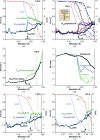How good are my data and what is the resolution?
- PMID: 23793146
- PMCID: PMC3689523
- DOI: 10.1107/S0907444913000061
How good are my data and what is the resolution?
Abstract
Following integration of the observed diffraction spots, the process of `data reduction' initially aims to determine the point-group symmetry of the data and the likely space group. This can be performed with the program POINTLESS. The scaling program then puts all the measurements on a common scale, averages measurements of symmetry-related reflections (using the symmetry determined previously) and produces many statistics that provide the first important measures of data quality. A new scaling program, AIMLESS, implements scaling models similar to those in SCALA but adds some additional analyses. From the analyses, a number of decisions can be made about the quality of the data and whether some measurements should be discarded. The effective `resolution' of a data set is a difficult and possibly contentious question (particularly with referees of papers) and this is discussed in the light of tests comparing the data-processing statistics with trials of refinement against observed and simulated data, and automated model-building and comparison of maps calculated with different resolution limits. These trials show that adding weak high-resolution data beyond the commonly used limits may make some improvement and does no harm.
Keywords: data reduction; data scaling; data statistics; software.
Figures



References
Publication types
MeSH terms
Grants and funding
LinkOut - more resources
Full Text Sources
Other Literature Sources

